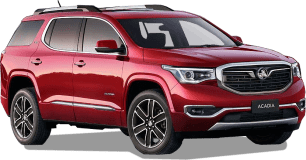The LTZ is 4887mm long (with a 2845mm wheelbase), 1902mm wide (excl mirrors), and 1846mm high. It has a kerb weight of 2203kg.
Its turning circle is 12m but it feels like more of a cumbersome beast when trying to manoeuvre in the bush or in the city, though not enough so for that characteristic to be any sort of deal-breaker.
The tilt-adjustable, electrically assisted steering lacks any reach-adjustment, which is annoying, but it can still be counted on to deliver a precise feel – light at low speeds, heavier at high speeds – when pushing the Trailblazer along at a fair clip on open roads or in and out of corners.
Acceleration seems livelier now; there is more off-the-mark oomph for take-offs and safe, smooth overtaking, even on long gradual climbs, than before. The torquey engine and six-speed auto – with its smooth changes and gear-holding when appropriate – make for a high-achieving combo.
Ride and handling seem better than in Colorado7 guise although the tweaked suspension – Aussie-tuned coil-spring front and coil-spring live-axle rear – and Bridgestone Dueler H/Ts tyres* may account for some of that. However, we did feel some body-roll while driving along back roads, unlike the last time we were in a Trailblazer LTZ. (*The Trailblazer has a full-sized 18-inch spare.)
The locally tuned suspension is, at times, a bit too firm; when we hit heavy bumps and deep potholes on rough gravel tracks several times, we were unsettled because the Trailblazer’s suspension bashed its way over and through.
NVH levels on open-road bitumen can still tend towards the rougher side of things with diesel engine clatter, tyre roar and wind rush clattering a tune on your ear drums.
We completed a series of emergency braking scenarios – on bitumen and dirt – and the Trailblazer’s disc brakes – 300mm at the front and 318mm at the rear – helped rip us into a controlled stop.
Off-road, we had a ball because the beefy Trailblazer seems a much better fit for gravel-track fast blasts and slow-going bush driving than it does for any jaunts in the stop-start city.
Our drive loop included a decent bit of four-wheel driving – coastal sand, bush tracks peppered with rocks of all shapes and sizes, and shallow mud in a dried-out dam. Drive modes can be switched via the centre console dial between 2H, 4H and 4L; high range modes are actually represented by an ‘up’ arrow on the dial; low range is a ‘down’ arrow. Bonus: the Trailblazer’s 500Nm of torque is readily available from way down low.
The Trailblazer has a limited slip diff, 218mm of ground clearance and a wading depth of 600mm, which was never tested as our usual creek crossings were so bone-dry they were more like puddles. Approach, departure and ramp-over angles are 28, 25, 22 respectively.
Its armoury of off-road tech – auto hill-start assist, hill-descent control and more – make it almost unstoppable, straight out of the showroom, for anything demanded of it on a light- to medium-difficulty adventure weekend.
Its 76-litre fuel tank, however, hinders any claim it has to off-road touring potential.
The Trailblazer has 3000kg towing capacity (braked); 750kg unbraked.
Note: Holden has persisted with a system which, when you open a door, the front windows automatically slide down a bit, an action aimed at reducing air pressure when you close the doors. It remains annoying but we still weren’t annoyed enough to actually bother to check the owner’s manual for a possible hack to switch it off.











.png)























.png)


















